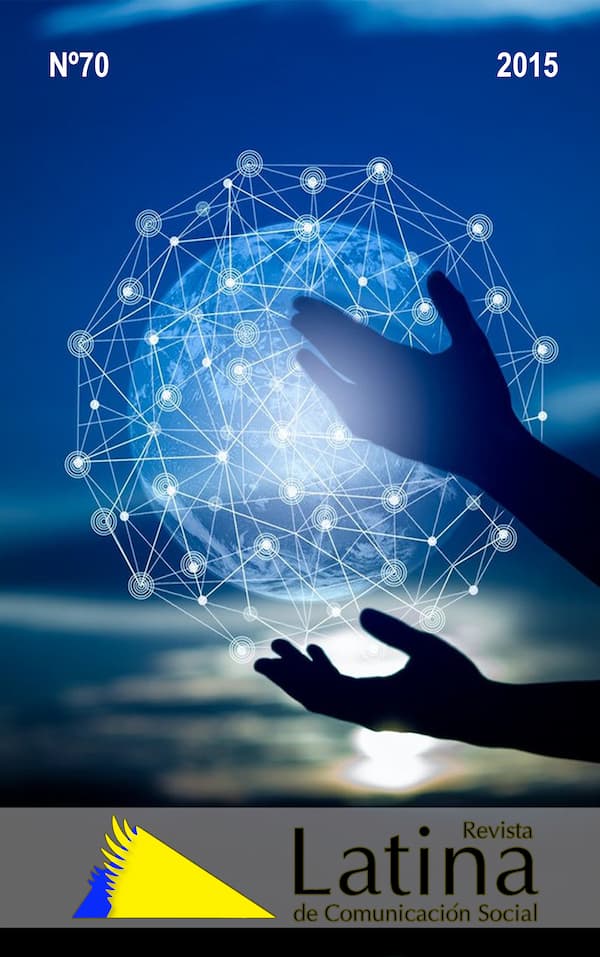Communication research using BigData methodology
DOI:
https://doi.org/10.4185/RLCS-2015-1076Keywords:
Big Data, data mining, contents analysis, methodology, epistemology, scientific representation, communication researchAbstract
Digital technologies are enabling new tools and analysis methodologies in the field of communication, as well as in other research areas. In this document, we approach aspects related to communication research using the Big Data methodology, which is generating much expectation and showing good results in other scientific areas. Methodology: A set of articles were used as corpus for this work and we applied the Big Data analysis and representation techniques as contents analysis methodology over this sample in order to evaluate its relevance and effectiveness. Conclusions: As a result of our study, we can conclude that this methodology can be useful in our field of knowledge, but it has a limited effectiveness though.
Downloads
References
Anscombe, F. J. (1973): "Graphs in Statistical Analysis,". En: American Statistician, 27, pp. 17-21. DOI: https://doi.org/10.1080/00031305.1973.10478966
Burrows, R. and Savage, M. (2014): “After the crisis? Big Data and the methodological challenges of empirical sociology”. En: Big Data & Society, pp. 1–6. DOI: https://doi.org/10.1177/2053951714540280
D’heer, E. and Verdegem, P. (2014): “Conversations about the elections on Twitter: Towards a structural understanding of Twitter’s relation with the political and the media field”. En: European Journal of Communication. 29(6), pp. 720–734. DOI: https://doi.org/10.1177/0267323114544866
Feyerabend, P. K. (1975): Tratado contra el método. Esquema de una teoría anarquista del conocimiento. Madrid: Tecnos, ed. 1981.
Fisher, E. (2015): “‘You Media’: audiencing as marketing in social media”. En: Media, Culture & Society, 37(1) pp. 50–67. DOI: https://doi.org/10.1177/0163443714549088
Focault, B. & Meirelles, I. (2015): “Visualizing Computational Social Science: The Multiple Lives of a Complex Image”. En: Science Communication, 37(1), pp. 34-58. DOI: https://doi.org/10.1177/1075547014556540
Ford, B. J. (1992): Images of Science: A History of Scientific Illustration. London: British Library.
Gregg, M. (2015): “Inside the Data Spectacle”. En: Television & New Media, 16(1), pp. 37–51. DOI: https://doi.org/10.1177/1527476414547774
Gross, A. (2006): “The Verbal and the Visual in Science: A Heideggerian Perspective”. En: Science in Context, 19(4), pp. 443-474. DOI: https://doi.org/10.1017/S0269889706001037
Gurevitch, L. (2014): “Google Warming: Google Earth as eco-machinima”. En: Convergence, 20(1), pp. 85–107 DOI: https://doi.org/10.1177/1354856513516266
Kitchin, B. (2014): “Big Data, new epistemologies and paradigm shifts”. En: Big Data & Society, pp. 1–12. DOI: https://doi.org/10.1177/2053951714528481
Kuhn, T. S. (1962): The Structure of Scientific Revolutions. Chicago: Chicago University Press
Latour, B. (2009): “Tarde’s idea of quantification”. En: The Social after Gabriel Tarde: Debates and Assessments. London: ed. Candea, M. Routledge, pp. 145–162.
Leonelli, S. (2014): “What difference does quantity make? On the epistemology of Big Data in biology, en Big Data & Society, pp. 1–11. DOI: https://doi.org/10.1177/2053951714534395
Lynch, M. (2006): “The Production of Scientific Images. Vision and Re-Vision in the History, Philosophy, and Sociology of Science”, Visual Cultures of Science: rethinking representational practices in knowledge building and science communication. Hanover, N.H.: Dartmouth Collegue Press., p. 26 y ss.
Lyon, D. (2014): “Surveillance, Snowden, and Big Data: Capacities, consequences, critique”. En: Big Data & Society, pp. 1–13. DOI: https://doi.org/10.1177/2053951714541861
Manovich, L. (2002): “The Anti-Sublime Ideal in Data Art”, disponible en https://illinoissquaire.web.illinois.edu/wp/2018/11/15/the-anti-sublime-ideal-in-data-art/
Murthy, D. y Bowman, S. (2014): “Big Data solutions on a small scale: Evaluating accessible high-performance computing for social research”. En: Big Data & Society, pp. 1–12. DOI: https://doi.org/10.1177/2053951714559105
Penney, J. (2014): “Motivations for participating in ‘viral politics’: A qualitative case study of Twitter users and the 2012 US presidential election”, en Convergence, DOI: https://doi.org/10.1177/1354856514532074
Raghavan, P. (2014): “It’s time to scale the science in the social sciences”. En: Big Data & Society, pp 1–4. DOI: https://doi.org/10.1177/2053951714532240
Schroede, R. (2014): “Big Data and the brave new world of social media research”. En: Big Data & Society, pp. 1–11. DOI: https://doi.org/10.1177/2053951714563194
Taylor, L., Schroeder, R. y Meyer, E. (2014): “Emerging practices and perspectives on Big Data analysis in economics: Bigger and better or more of the same?”. En: Big Data & Society, pp. 1–10. DOI: https://doi.org/10.1177/2053951714536877
Vilches, L. (coord.) (2011): La investigación en comunicación. Métodos y técnicas en la era digital. Barcelona: Gedisa.
Zwitter, A. (2014): “Big Data ethics”. En: Big Data & Society, pp. 1–6. DOI: https://doi.org/10.1177/2053951714559253








